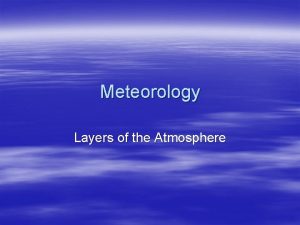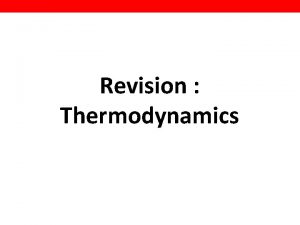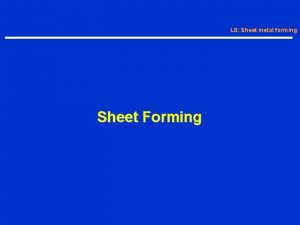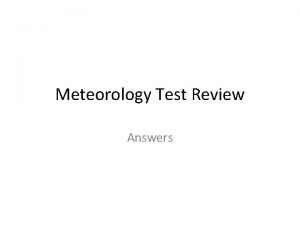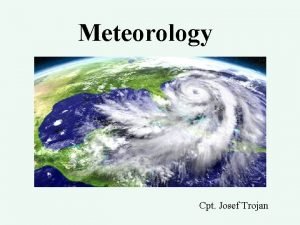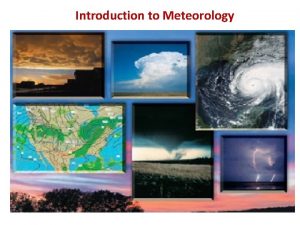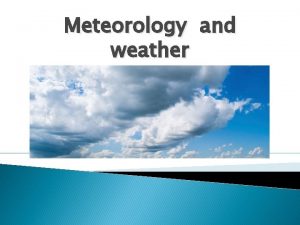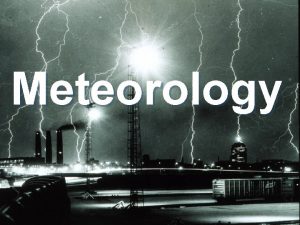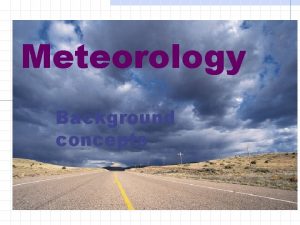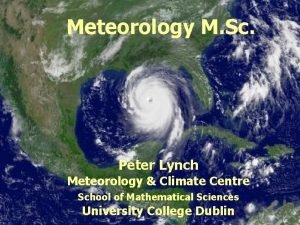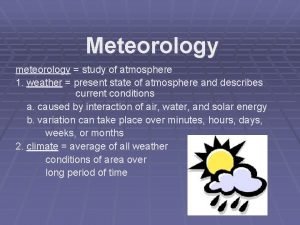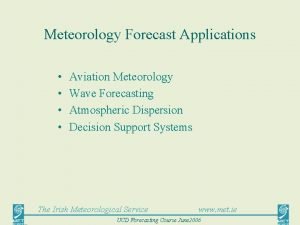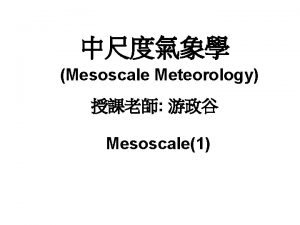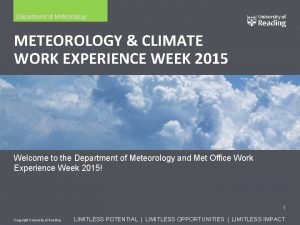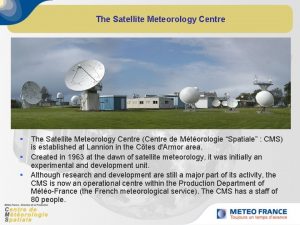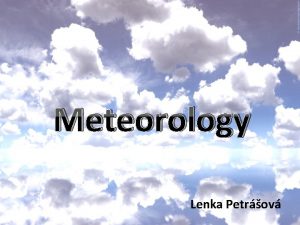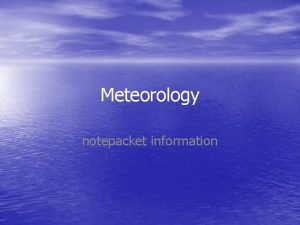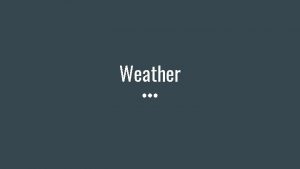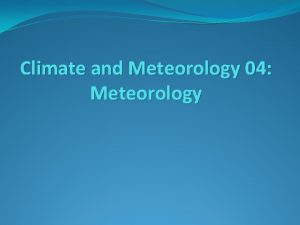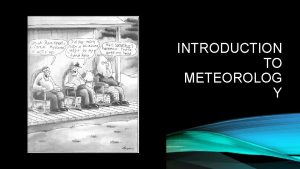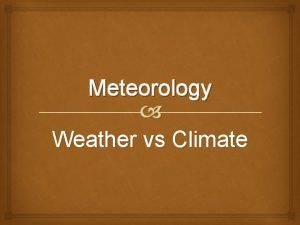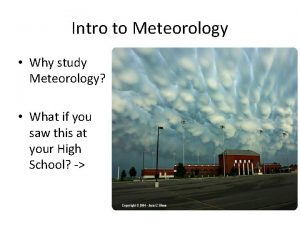Meteorology Review Sheet Answers 1 The for main





























- Slides: 29

Meteorology Review Sheet Answers

1. The for main layers of the atmosphere are • troposphere • stratosphere • mesosphere • thermosphere

2. What are the main gases in the atmosphere? • Nitrogen – 78% • Oxygen – 21% • Argon -. 934 % • Carbon Dioxide. 036%

3. Review the 10 types of clouds

Cumulus = puffy Cirrus = wispy Cirro = high level Alto – middle level Nimbus = rain Alto cumulus Stratus = layers Strato = low level

4. Define the following words Hydrosphere – all the water on Earth – solid, liquid and gas Relative Humidity – amount of water vapor in air compared to amount the air could hold. Dew Point – temperature at which condensation occurs Saturated Air – Air is holding all the water vapor it can hold (RH = 100%) Sling psychrometer – instrument used to find dew point and relative humidity Condensation nuclei – particles around which condensation occurs – needed to form clouds

5. Use the charts on page 704 to answer: Dry Bulb = 24 Dry Bulb = 16 Wet bulb = 21 Wet bulb = 10 Depression = 3 Depression = 6 Dew Point = 20 Dew Point = 4 Relative Humidity = 76% Relative Humidity = 45%

6. What is air pressure? Air pressure is the weight of the air pushing on earth’s surface.

7. Air pressure is measured with a barometer. The 2 types are aneroid and mercury.

8. How does air pressure change with altitude? Air pressure decreases as altitude increases.

9. Put an H or L next to each description of pressure characteristics below. Cold temperatures H Rising air L Poor weather L Warm temps L Fair weather H Air moving in L Air moving out H Rising barometer H

10. A line connecting points of equal pressure is an isobar. They are 4 mb apart.

11. Label the lines below and draw in the movement of the wind. 1004 1000 L 996 H 1008 1012

12. Winds always moves from high pressure to low pressure. They are named according to the direction they come from. 13. Winds curve due to the Coriolis Effect. This is caused by Earth’s rotation. In the northern hemisphere, winds curve to the right and in the southern hemisphere, they curve to the left.

14. Label the pressure belts

14. Label the wind belts

16. What wind moves weather across the United States? Prevailing westerlies and the Jet Stream

17. What is an air mass? A body of air with the characteristics of the area it forms over.

18. Fill in the table below on air masses. Area affected Name Temp Moisture Where formed c. P Continenta l polar Cold Dry On land, near the poles Northern central US c. T Continenta l tropical Warm Dry On land near the equator Southern central US m. P Maritime polar Cold Wet Over water near the poles Northeaste rn and northweste rn US m. T Maritime tropical Warm Wet Over water near the equator Southeast ern and southwest ern US

19. What is a front? A front is the boundary between 2 air masses. They move west to east across the US

20. Warm Front

20. Cold Front

20. Stationary Front

20. Occluded Front

21. A weather pattern frequently experienced by the United States due to the boundary between the polar easterlies and the prevailing westerlies is a traveling cyclone.

Review! The 3 types of heat transfer are: • Conduction- due to contact, like touching a hot stove • Convection- due to differences in density (lava lamp) • Radiation – by electromagnetic waves – like the energy that comes from the sun

What is the coldest part of the day? What is the warmest part of the day?

Stations Models Wind dir and speed Air temp Pressure Dew point Sky coverage

Good luck on the test!
 Stock verification sheet
Stock verification sheet Iso 22301 utbildning
Iso 22301 utbildning Novell typiska drag
Novell typiska drag Nationell inriktning för artificiell intelligens
Nationell inriktning för artificiell intelligens Vad står k.r.å.k.a.n för
Vad står k.r.å.k.a.n för Shingelfrisyren
Shingelfrisyren En lathund för arbete med kontinuitetshantering
En lathund för arbete med kontinuitetshantering Underlag för särskild löneskatt på pensionskostnader
Underlag för särskild löneskatt på pensionskostnader Tidbok för yrkesförare
Tidbok för yrkesförare Anatomi organ reproduksi
Anatomi organ reproduksi Vad är densitet
Vad är densitet Datorkunskap för nybörjare
Datorkunskap för nybörjare Tack för att ni lyssnade bild
Tack för att ni lyssnade bild Debattartikel struktur
Debattartikel struktur Delegerande ledarstil
Delegerande ledarstil Nyckelkompetenser för livslångt lärande
Nyckelkompetenser för livslångt lärande Påbyggnader för flakfordon
Påbyggnader för flakfordon Kraft per area
Kraft per area Offentlig förvaltning
Offentlig förvaltning Bo bergman jag fryser om dina händer
Bo bergman jag fryser om dina händer Presentera för publik crossboss
Presentera för publik crossboss Teckenspråk minoritetsspråk argument
Teckenspråk minoritetsspråk argument Kanaans land
Kanaans land Treserva lathund
Treserva lathund Epiteltyper
Epiteltyper Claes martinsson
Claes martinsson Cks
Cks Lågenergihus nyproduktion
Lågenergihus nyproduktion Mat för unga idrottare
Mat för unga idrottare Verktyg för automatisering av utbetalningar
Verktyg för automatisering av utbetalningar






























